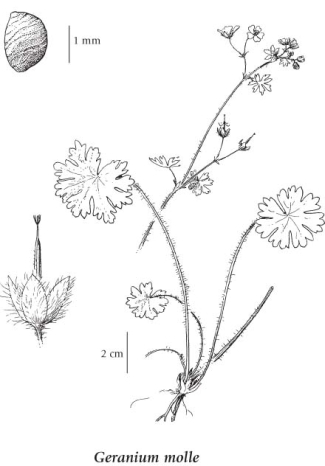Geranium molle L.
dovefoot geranium (dovefoot crane's-bill)
Geraniaceae (Geranium family)
Introduction to Vascular Plants
dovefoot geranium (dovefoot crane's-bill)
Geraniaceae (Geranium family)
Introduction to Vascular Plants
Species Information
General:
Annual herb from a taproot; stems decumbent to ascending, stiff-hairy, 10-40 cm tall.
Leaves:
Basal leaves few, kidney-shaped in outline, long-stalked, 1.5-5 cm long; divided into 5-7 broad, coarsely toothed lobes, stem leaves few, similar, opposite, short-stalked.
Flowers:
Inflorescence of terminal clusters of usually 2 short-stalked flowers; petals pink, shallowly notched, 3-5 mm long, soft-hairy; sepals slightly shorter than the petals, the tips abruptly pointed; stamens fertile, 10, fused basally.
Fruits:
Carpels, glabrous, finely cross-wrinkled; styles 6-8 mm long, the beak 1-2 mm long; seeds orbicular, glabrous.
Illustration

If more than one illustration is available for a species (e.g., separate illustrations were provided for two subspecies) then links to the separate images will be provided below. Note that individual subspecies or varietal illustrations are not always available.
Illustration Source: The Illustrated Flora of British Columbia
Ecology
Ecological Framework for Geranium molle
The table below shows the species-specific information calculated from
original data (BEC database) provided by the BC Ministry of Forests and Range.
(Updated August, 2013)
The table below shows the species-specific information calculated from
original data (BEC database) provided by the BC Ministry of Forests and Range.
(Updated August, 2013)
| Site Information |
Value / Class |
||
|
Avg |
Min |
Max |
|
| Elevation
(metres) |
92 | 24 | 259 |
| Slope
Gradient (%) |
28 | 0 | 100 |
|
Aspect (degrees) |
206 | 38 | 360 |
| Soil
Moisture Regime (SMR) [0 - very xeric; 4 - mesic; 8 - hydric] |
1 | 0 | 2 |
| Modal
Nutrient Regime
Class |
D | ||
| #
of field plots species was recorded in: |
33 | ||
| Modal
BEC Zone Class |
CDF | ||
|
All BEC Zones (# of stations/zone) species was recorded in |
CDF(23) | ||
|
Source:
Klinkenberg 2013
|
|||
Habitat and Range
Mesic fields, lawns and waste places in the lowland zone; common in SW BC, rare northward along the coast; introduced from Eurasia.Status Information
Taxonomic Notes
Dove's foot cranes-bill ... usually has magenta to pink flowers. But populations polymorphic for magenta and white-flowered plants occur--for example, at Redwood Park in Delta. The white-flowered plants probably represent recessive homozygotes at a single gene that have become established by chance in this population.
Source: Griffiths and Ganders. 1983. Wildflower Genetics: A Field Guide for British Columbia and the Pacific Northwest. |
References
Griffiths, Anthony J. F. and Fred R. Ganders. 1983. Wildflower Genetics: A Field Guide for British Columbia and the Pacific Northwest. Flight Press, Vancouver.